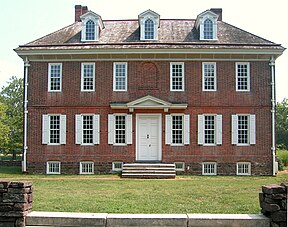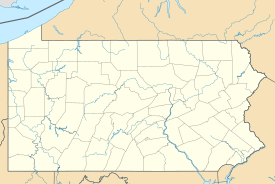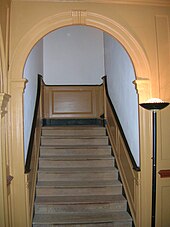Hope Lodge
| Hope Lodge | ||
|---|---|---|
| National Register of Historic Places | ||
|
Hope Lodge (front view) |
||
|
|
||
| location | Fort Washington , Montgomery County , Pennsylvania | |
| Coordinates | 40 ° 7 '30 " N , 75 ° 13' 0.3" W | |
| Built | 1743-48 | |
| architect | Edmund Woolley | |
| Architectural style | Georgian architecture | |
| NRHP number | 72001141 | |
| The NRHP added | April 26, 1972 | |
Hope Lodge is a historic building in Fort Washington, Pennsylvania . It is listed on the National Register of Historic Places and is considered a major example of Georgian architecture in the United States.
history
Two years after he had acquired the property in White Marsh Estate, who built Quaker and businessman Samuel Morris Hope Lodge from 1743 to 1748. Morris' sources of income included the short distance beyond the today's Bethlehem Pike lying Schrotmühle Farmar Mill , which belonged to him from 1746 , as well as the 150 acres of farmed property around Hope Lodge. He also owned a limestone quarry and lime kiln and a third of the iron forge Chelsea Forge in Warren County, New Jersey . He was one of eight Philadelphia County's assessors since 1736 and was re-elected three times.
The architect of the Georgian-style manor was Edmund Woolley from Philadelphia , who also designed Independence Hall . This is suggested by supplies of building materials to him recorded in Morris' books. When Morris died unmarried and without children at the age of 61, his oldest living brother inherited the property in 1770 and sold it to William West. Likewise, Morris determined in his will to build a vacant school on the Whitemarsh Estate, the second in the state. It was in operation until the beginning of the 20th century.
William West, born in 1724 in Ireland, was a haberdasher from Philadelphia . He did business with Indians , welcomed influential people like John Adams as guests to Hope Lodge, and invested in land in western Pennsylvania. He was a member of the American Philosophical Society founded by Benjamin Franklin in Philadelphia in 1743 . Together with other members of the House of Burgesses , which had been dissolved by the British Crown , he signed a series of import ban declarations in Raleigh Tavern , Williamsburg (Virginia) from 1765 to protest against the import duties of the Townshend Acts . In 1776 he moved to Hope Lodge with his nephew, William West, Jr., who founded the first city militia in Philadelphia and served as a major in the Continental Army , which was also due to the advance of the troops of the British Empire . From November 1776 to August 1777, West's nephew was a prisoner in the British Army. When he was released he was living with his uncle at Hope Lodge. In the course of the war and suspected of treason by some of his people, he was arrested again by the British and interned on a prison ship . Released after the end of the Revolutionary War, he did not return to Hope Lodge, but from then on lived in Baltimore.
In the aftermath of the lost Battle of Brandywine , George Washington rallied his troops in Whitemarsh in September 1777. The encampment stayed there for five weeks before moving on to Valley Forge . Since West was an outspoken patriot, his property was under the personal protection of John Fitzgerald, George Washington's aide-de-camp . William West lived in comparable luxury until his death on October 28, 1782. His family left the area and in 1784 sold the estate to Henry Hope for more than 4,500 Pennsylvania pounds .
Hope owned Hope and Company , which had branches in London and Amsterdam. He had such a high international reputation in the financial world that Adam Smith dedicated an edition of his work The Wealth of Nations to him. Hope had bought Whitemarsh Estate as a wedding gift and placed it in the administrative hands of James Horatio Watmough, who then renamed it Hope Lodge. Watmough became formal owner on July 23, 1807. He was a well-traveled long-distance trader. One of his seven children, John Goddard Watmough, was considered a hero of the British-American War and was later successful in politics as a member of Congress . In addition to members of the Watmoughs, other families by marriage such as B. the reeds on Hope Lodge, which can be assigned to the establishment at the time.
In 1831 Jacob Wenz and his family leased Hope Lodge, and the following year he bought it from the Watmoughs for $ 18,000. Wenz was a wealthy businessman and used the property for the agricultural production of milk, grain, straw and hay. He also owned a limestone quarry and lime kiln south of Hope Lodge on Bethlehem Pike. In 1859, four years after his death, the property was divided among his sons. Thomas Jolly Wentz received 38 acres and the property and continued to operate it. Wentz ran into financial difficulties so his property was auctioned off in 1886. His mother-in-law Sarah Streeper was awarded the contract. When she died, her daughter Mary Lightcap Streeper inherited the estate and probably continued to operate it until she sold it in 1921.
The Keasbey and Mattison Company of Ambler, Pennsylvania bought Hope Lodge for $ 40,000 to expand the local lime production facility. Keasbey and Mattison were keen to preserve the historic building, so the following year they advertised the purchase of the historically significant house with leaflets, with which they were successful with William and Alice Degn the following year.
The degns, who paid $ 35,000 for the property and 36 acres, were from north Philadelphia and Germantown . After an expansion of Hope Lodge, in which the property was electrified and a wing of the building was added, they moved there year-round in 1927. They tried to preserve or restore Hope Lodge, added antiques from the 18th and 19th centuries to the interior and asked the well-known architect Paul Philippe Cret for assistance. Today's, faithful to the original door gable is attributed to him. William Degn was a member of the Historical Society of Pennsylvania . On his initiative and donation, among other things, the Philadelphia newspaper Public Ledger managed to acquire an important founding document of Pennsylvania from 1682, which William Penn had drawn up in England. Degn used Hope Lodge for agriculture, with no commercial success, as the records show. When Degn died in 1940, his wife Alice inherited Hope Lodge. With her death in 1953 she donated the Hope Lodge Foundation in her last will to preserve the historic building.
In 1957 this foundation transferred its property to the state of Pennsylvania. On April 26, 1972 Hope Lodge was added to the National Register of Historic Places. Today the Pennsylvania Historical and Museum Commission manages and maintains Hope Lodge.
The interior of the rooms is partly based on the 18th century, partly still the originals of the Degns, who had furnished the rooms in the style of the Colonial Revival . In addition to the main building, there is a kitchen and a barn from the 18th century as well as a garage, a greenhouse and a tenant house from the 20th century on the property.
architecture
Hope Lodge is considered a major example of Georgian architecture in America. The special architectural and historical importance, which had since been forgotten, was rediscovered by Horace Mather Lippincott, who was a supporter of the Colonial Revival Movement . A key feature of Georgian architecture, which dominated the Thirteen Colonies between 1700 and 1780 , is a symmetrical room layout and facade. The rooms themselves are also designed symmetrically, for example with regard to the fireplace, doors and wall niches. It is also typical of this architectural style that the houses are two floors high and two rooms each are located to the left and right of the central axis, which is marked by the entrance door. This also applies to Hope Lodge.
literature
- Lorett Treese: Hope Lodge and Mather Mill . In: Pennsylvania Historical and Museum Commission (Ed.): Pennsylvania - Trail of history . Stackpole, Mechanicsburg 2001, ISBN 0-8117-2471-9 (English, online [accessed December 23, 2011]).
Web links
- Hope Lodge. In: Hope Lodge Historic Site website. Pennsylvania Historical and Museum Commission (PHMC) , accessed December 18, 2011 .
Individual evidence
- ↑ a b Samuel Morris, 1747 to 1770. In: Hope Lodge Historic Site website. Pennsylvania Historical and Museum Commission (PHMC) , accessed December 18, 2011 .
- ^ Woolley, Edmund (c. 1695-1771). Projects. In: Philadelphia Architects and Buildings. The Athenaeum of Philadelphia , accessed January 7, 2012 .
- ↑ a b The West Family, 1776 to 1784. In: Web presence Hope Lodge Historic Site. Pennsylvania Historical and Museum Commission (PHMC) , accessed December 18, 2011 .
- ^ The Watmoughs, 1784 to 1832. In: Hope Lodge Historic Site. Pennsylvania Historical and Museum Commission PHMC , accessed December 18, 2011 .
- ^ The Wentz Family, 1832 to 1921. In: Hope Lodge Historic Site website. Pennsylvania Historical and Museum Commission PHMC , accessed December 18, 2011 .
- ^ Keasbey and Mattison, 1921-1922. In: Hope Lodge Historic Site website. Pennsylvania Historical and Museum Commission PHMC , accessed December 18, 2011 .
- ^ William and Alice Degn, 1922 to 1957. In: Hope Lodge Historic Site website. Pennsylvania Historical and Museum Commission PHMC , accessed December 18, 2011 .
- ↑ Entry in the National Register Information System . National Park Service , accessed April 20, 2016
- ^ PHMC, 1957 to present. In: Hope Lodge Historic Site website. Pennsylvania Historical and Museum Commission PHMC , accessed December 18, 2011 .
- ↑ a b Lorett Treese: Hope Lodge and Mather Mill . In: Pennsylvania Historical and Museum Commission (Ed.): Pennsylvania - Trail of history . Stackpole, Mechanicsburg 2001, ISBN 0-8117-2471-9 , pp. 5–8 ( online [accessed December 23, 2011]).




